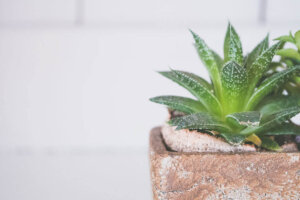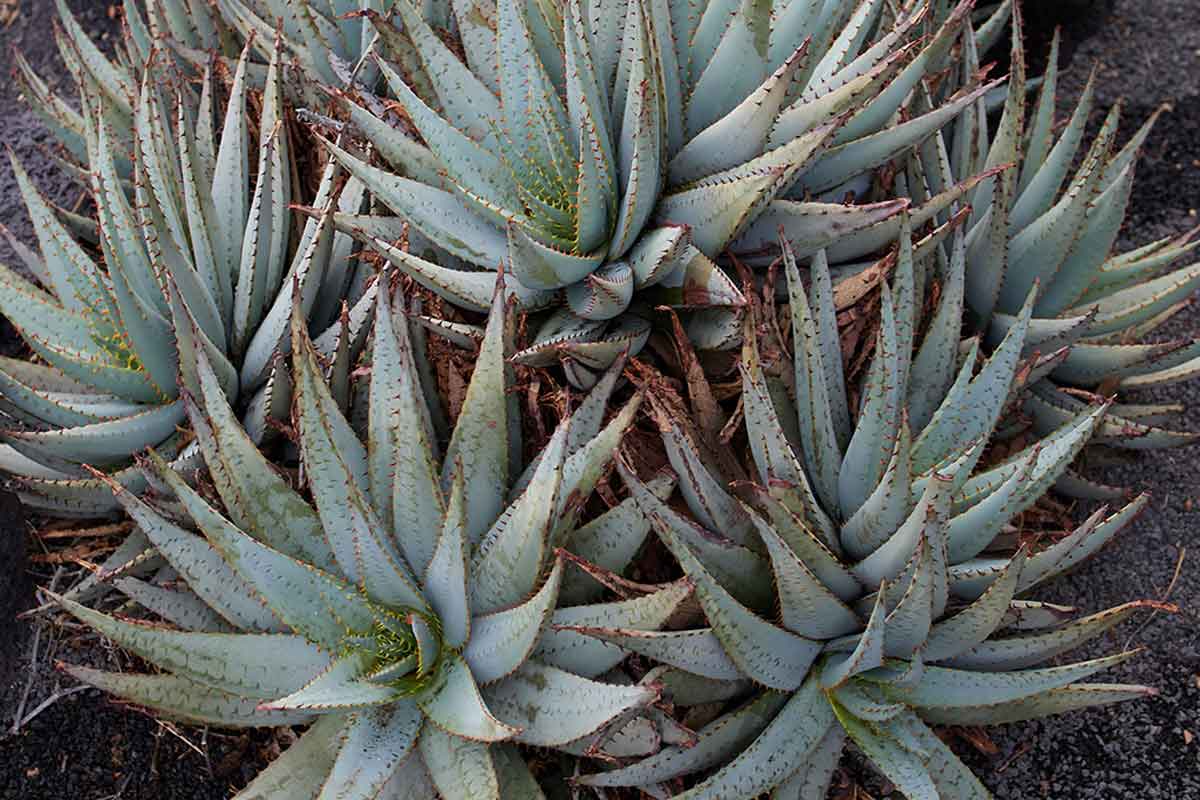Aloe Vera: How to Take Care of it at Home

Aloe vera is a well-known plant and it’s also simply referred to as aloe. It belongs to the genus of succulents and is native to Africa.
It’s likely that you’ve heard about a large number of benefits it offers that apply to physical health and even energy. There are those who consume it to alleviate all sorts of problems and others use it in the home to cleanse it of bad energies.
But this isn’t all that aloe can do! It helps to purify the air and it can be used as a decorative element in different ways. You can plant it in the ground, in pots, or place it in a pretty vase with water. It can be grown indoors and outdoors. Ready to discover more about aloe vera? Keep reading!
Aloe vera characteristics

Aloe vera has large leaves that are unmatched by other plants. They’re fleshy, lanceolate, and green in color with very particular yellow spots. In addition, they have spikes on the edges of their leaves and the plant can measure up to 15 cm high by 80 cm wide.
It has another great advantage and that is that it’s very easy to find. Many people grow it at home and it’s common to find it in local, medicinal markets. This has made it easier, over the years, for it to be used to alleviate different health problems.
Scientific studies highlight its use in industries such as pharmaceuticals, food, and cosmetics. The most used part of the plant is the gel that’s contained within its leaves, which has antioxidant and therapeutic properties.
How to grow aloe vera in your home
It’s common to find this plant in homes, as a decorative element or as a source of food and well-being. However, it’s necessary to provide it with special care to keep it healthy. Next, we tell you more about it.
Where to plant your aloe vera
As we already mentioned, aloe vera can be grown in a pot, in the ground, or in water. You can also choose whether to grow it outdoors or indoors. If you use a solid substrate, you’ll need to guarantee a depth of 50 centimeters. This will ensure that the roots root well and that it’ll absorb the necessary nutrients it needs.
What’s the most suitable ground?
The most suitable ground for this plant is one that contains good organic matter. This will ensure that your plant can grow in a medium that has all the nutrients it needs. Additionally, the substrate must drain water well, it must be aerated and it must be enough to cover the roots while they’re growing.
Aloe vera fertilizer
It’s necessary to take care of the land where your aloe is planted. The goal of this is to supplement the nutrients that have been absorbed from the already disposed soil. Depending on the climate, you should fertilize the area at the beginning of spring and at the end of summer.
Aloe irrigation

Aloe vera is the ideal plant for people who don’t have a lot of time to dedicate to their plants. This is because it doesn’t need constant care or abundant watering. Moreover, its leaves are designed to reserve water and stay alive, even in adverse conditions.
As such, watering should be moderate and care must be taken that the substrate doesn’t become waterlogged. It’s recommendable to use a shower hose with small holes that allow you to better disperse and control the water. You can water it once a week or every 15 days, depending on the weather.
Suitable temperature
Since this is a plant that’s native to hot climates, it can withstand temperatures between 59 and 82 degrees Fahrenheit. However, low temperatures or frost prevent aloe vera from developing and its roots won’t grow as expected.
Aloe vera and light
By easily resisting high temperatures, aloe vera also withstands direct exposure to sunlight. However, this causes the leaves to dehydrate more quickly, turn yellow, or even burn.
It is best to place the plant in an area where it has access to moderate light.
Take advantage of your aloe vera and reproduce it
As the aloe vera grows, you’ll see how small leaves grow at the base. To reproduce it, let the small leaves grow up to 15 centimeters and then transplant them into another pot. This way you can make the most of your plant.
Aloe vera is a well-known plant and it’s also simply referred to as aloe. It belongs to the genus of succulents and is native to Africa.
It’s likely that you’ve heard about a large number of benefits it offers that apply to physical health and even energy. There are those who consume it to alleviate all sorts of problems and others use it in the home to cleanse it of bad energies.
But this isn’t all that aloe can do! It helps to purify the air and it can be used as a decorative element in different ways. You can plant it in the ground, in pots, or place it in a pretty vase with water. It can be grown indoors and outdoors. Ready to discover more about aloe vera? Keep reading!
Aloe vera characteristics

Aloe vera has large leaves that are unmatched by other plants. They’re fleshy, lanceolate, and green in color with very particular yellow spots. In addition, they have spikes on the edges of their leaves and the plant can measure up to 15 cm high by 80 cm wide.
It has another great advantage and that is that it’s very easy to find. Many people grow it at home and it’s common to find it in local, medicinal markets. This has made it easier, over the years, for it to be used to alleviate different health problems.
Scientific studies highlight its use in industries such as pharmaceuticals, food, and cosmetics. The most used part of the plant is the gel that’s contained within its leaves, which has antioxidant and therapeutic properties.
How to grow aloe vera in your home
It’s common to find this plant in homes, as a decorative element or as a source of food and well-being. However, it’s necessary to provide it with special care to keep it healthy. Next, we tell you more about it.
Where to plant your aloe vera
As we already mentioned, aloe vera can be grown in a pot, in the ground, or in water. You can also choose whether to grow it outdoors or indoors. If you use a solid substrate, you’ll need to guarantee a depth of 50 centimeters. This will ensure that the roots root well and that it’ll absorb the necessary nutrients it needs.
What’s the most suitable ground?
The most suitable ground for this plant is one that contains good organic matter. This will ensure that your plant can grow in a medium that has all the nutrients it needs. Additionally, the substrate must drain water well, it must be aerated and it must be enough to cover the roots while they’re growing.
Aloe vera fertilizer
It’s necessary to take care of the land where your aloe is planted. The goal of this is to supplement the nutrients that have been absorbed from the already disposed soil. Depending on the climate, you should fertilize the area at the beginning of spring and at the end of summer.
Aloe irrigation

Aloe vera is the ideal plant for people who don’t have a lot of time to dedicate to their plants. This is because it doesn’t need constant care or abundant watering. Moreover, its leaves are designed to reserve water and stay alive, even in adverse conditions.
As such, watering should be moderate and care must be taken that the substrate doesn’t become waterlogged. It’s recommendable to use a shower hose with small holes that allow you to better disperse and control the water. You can water it once a week or every 15 days, depending on the weather.
Suitable temperature
Since this is a plant that’s native to hot climates, it can withstand temperatures between 59 and 82 degrees Fahrenheit. However, low temperatures or frost prevent aloe vera from developing and its roots won’t grow as expected.
Aloe vera and light
By easily resisting high temperatures, aloe vera also withstands direct exposure to sunlight. However, this causes the leaves to dehydrate more quickly, turn yellow, or even burn.
It is best to place the plant in an area where it has access to moderate light.
Take advantage of your aloe vera and reproduce it
As the aloe vera grows, you’ll see how small leaves grow at the base. To reproduce it, let the small leaves grow up to 15 centimeters and then transplant them into another pot. This way you can make the most of your plant.
All cited sources were thoroughly reviewed by our team to ensure their quality, reliability, currency, and validity. The bibliography of this article was considered reliable and of academic or scientific accuracy.
- R.N. Domínguez-Fernández y col./ Revista Mexicana de Ingeniería Química Vol. 11, No. 1 (2012) 23-43.







